Overcoming Disengagement in Mathematics Classrooms
VerifiedAdded on 2023/06/03
|12
|3233
|456
AI Summary
This article discusses the issues of disengagement in mathematics classrooms and proposes practical approaches and innovative teaching methods to overcome them. It covers topics such as classroom disengagement, design thinking methodology, and methods of learning and teaching. The article also emphasizes the importance of digital literacy and multimodal learning in creating a conducive learning environment.
Contribute Materials
Your contribution can guide someone’s learning journey. Share your
documents today.
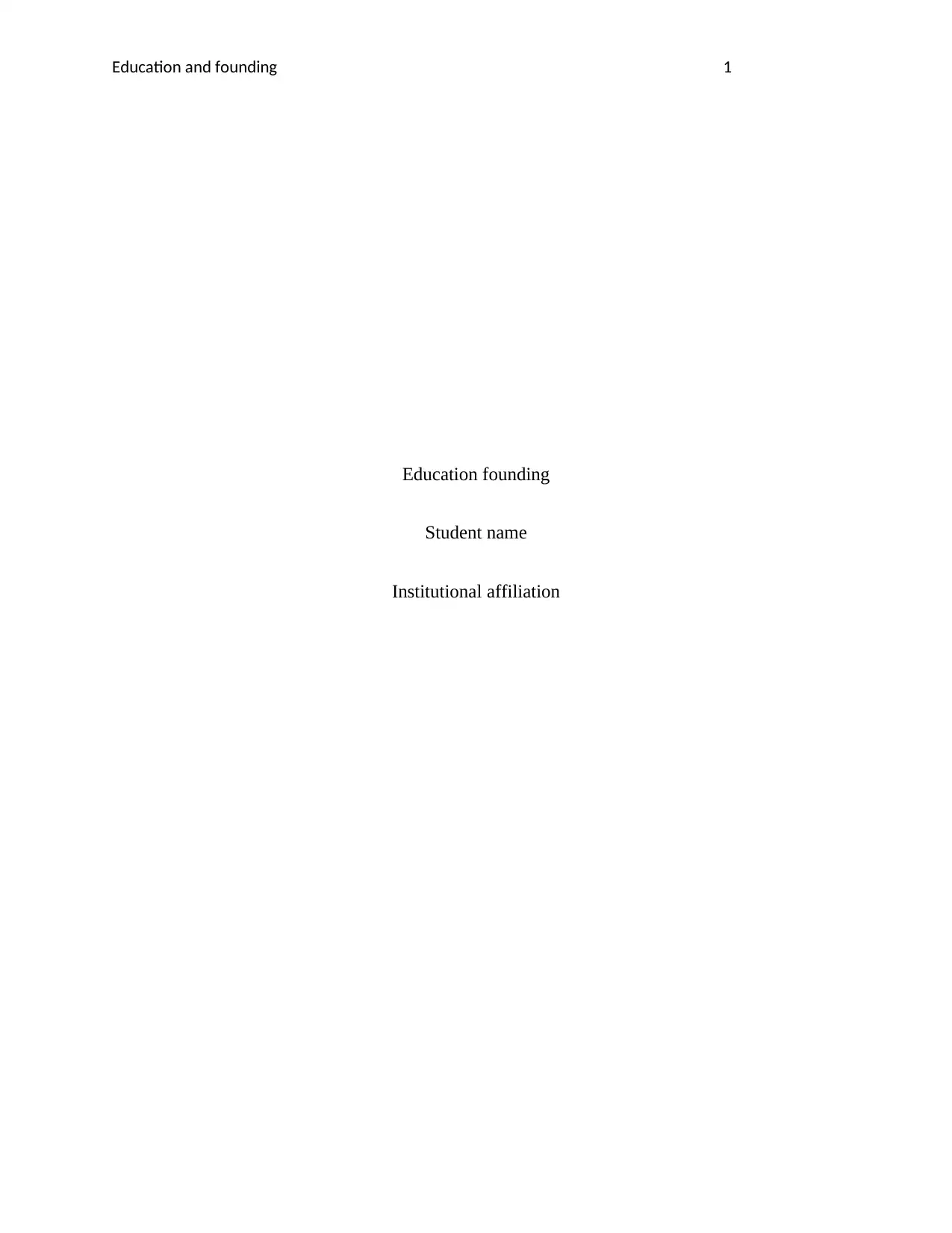
Education and founding 1
Education founding
Student name
Institutional affiliation
Education founding
Student name
Institutional affiliation
Secure Best Marks with AI Grader
Need help grading? Try our AI Grader for instant feedback on your assignments.
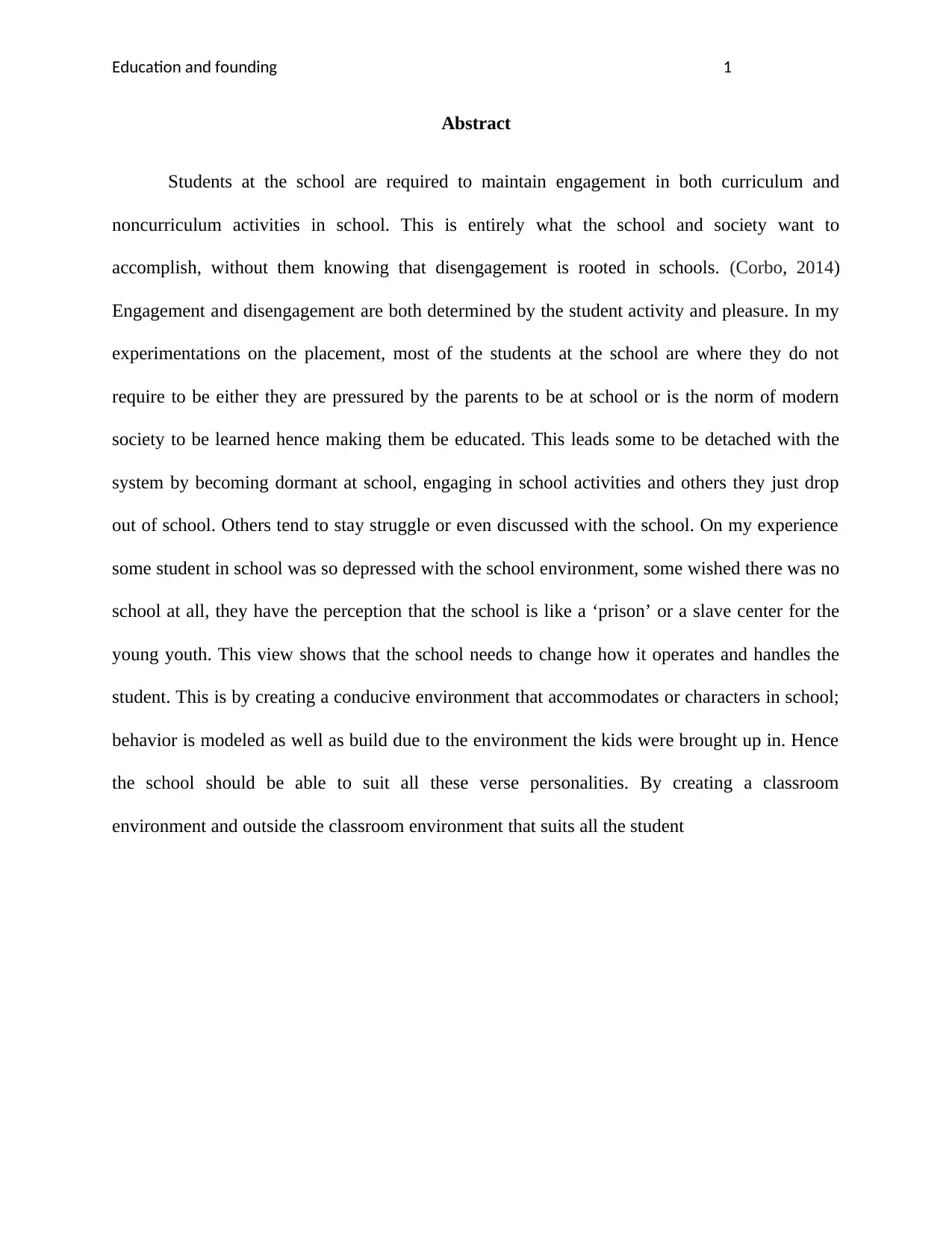
Education and founding 1
Abstract
Students at the school are required to maintain engagement in both curriculum and
noncurriculum activities in school. This is entirely what the school and society want to
accomplish, without them knowing that disengagement is rooted in schools. (Corbo, 2014)
Engagement and disengagement are both determined by the student activity and pleasure. In my
experimentations on the placement, most of the students at the school are where they do not
require to be either they are pressured by the parents to be at school or is the norm of modern
society to be learned hence making them be educated. This leads some to be detached with the
system by becoming dormant at school, engaging in school activities and others they just drop
out of school. Others tend to stay struggle or even discussed with the school. On my experience
some student in school was so depressed with the school environment, some wished there was no
school at all, they have the perception that the school is like a ‘prison’ or a slave center for the
young youth. This view shows that the school needs to change how it operates and handles the
student. This is by creating a conducive environment that accommodates or characters in school;
behavior is modeled as well as build due to the environment the kids were brought up in. Hence
the school should be able to suit all these verse personalities. By creating a classroom
environment and outside the classroom environment that suits all the student
Abstract
Students at the school are required to maintain engagement in both curriculum and
noncurriculum activities in school. This is entirely what the school and society want to
accomplish, without them knowing that disengagement is rooted in schools. (Corbo, 2014)
Engagement and disengagement are both determined by the student activity and pleasure. In my
experimentations on the placement, most of the students at the school are where they do not
require to be either they are pressured by the parents to be at school or is the norm of modern
society to be learned hence making them be educated. This leads some to be detached with the
system by becoming dormant at school, engaging in school activities and others they just drop
out of school. Others tend to stay struggle or even discussed with the school. On my experience
some student in school was so depressed with the school environment, some wished there was no
school at all, they have the perception that the school is like a ‘prison’ or a slave center for the
young youth. This view shows that the school needs to change how it operates and handles the
student. This is by creating a conducive environment that accommodates or characters in school;
behavior is modeled as well as build due to the environment the kids were brought up in. Hence
the school should be able to suit all these verse personalities. By creating a classroom
environment and outside the classroom environment that suits all the student
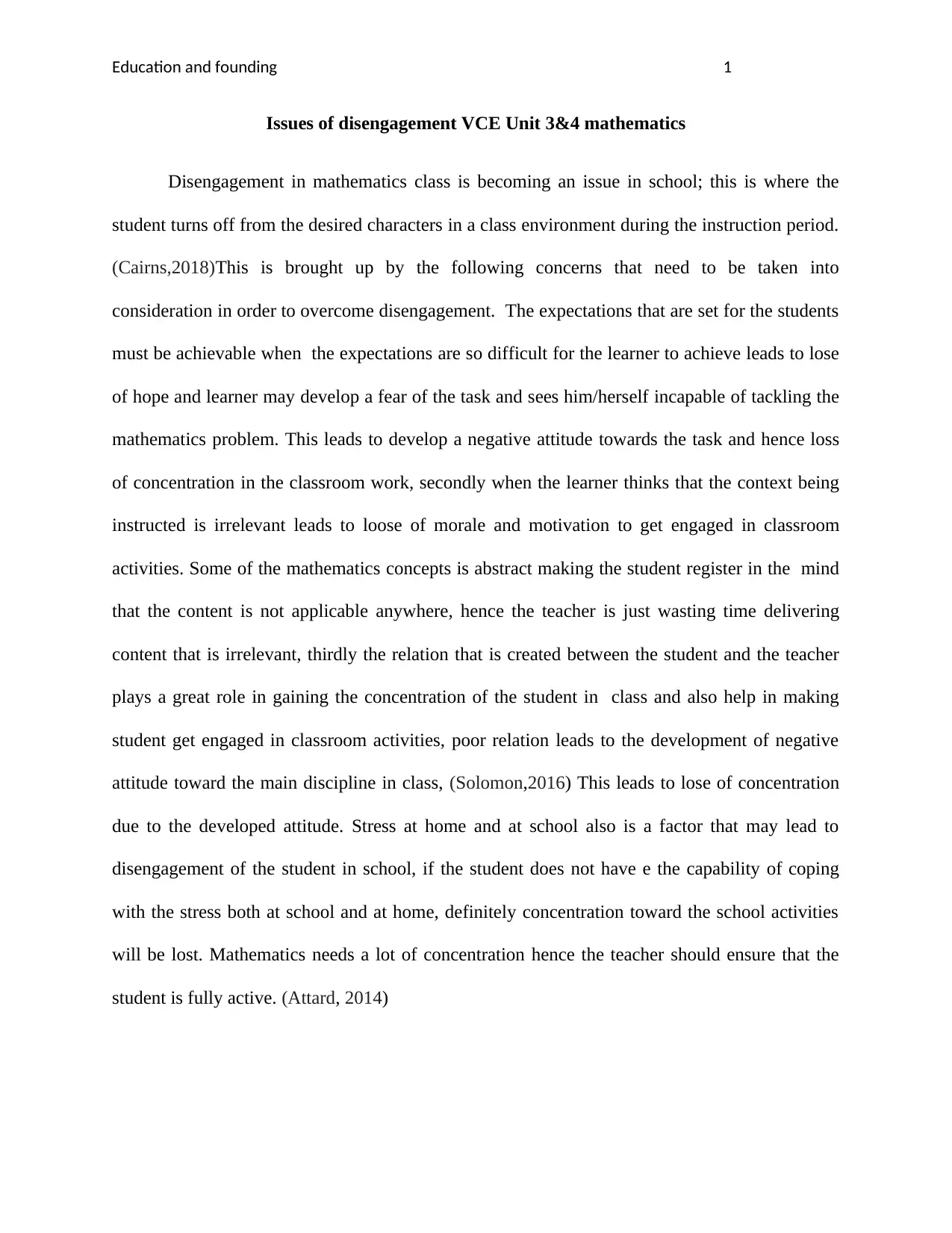
Education and founding 1
Issues of disengagement VCE Unit 3&4 mathematics
Disengagement in mathematics class is becoming an issue in school; this is where the
student turns off from the desired characters in a class environment during the instruction period.
(Cairns,2018)This is brought up by the following concerns that need to be taken into
consideration in order to overcome disengagement. The expectations that are set for the students
must be achievable when the expectations are so difficult for the learner to achieve leads to lose
of hope and learner may develop a fear of the task and sees him/herself incapable of tackling the
mathematics problem. This leads to develop a negative attitude towards the task and hence loss
of concentration in the classroom work, secondly when the learner thinks that the context being
instructed is irrelevant leads to loose of morale and motivation to get engaged in classroom
activities. Some of the mathematics concepts is abstract making the student register in the mind
that the content is not applicable anywhere, hence the teacher is just wasting time delivering
content that is irrelevant, thirdly the relation that is created between the student and the teacher
plays a great role in gaining the concentration of the student in class and also help in making
student get engaged in classroom activities, poor relation leads to the development of negative
attitude toward the main discipline in class, (Solomon,2016) This leads to lose of concentration
due to the developed attitude. Stress at home and at school also is a factor that may lead to
disengagement of the student in school, if the student does not have e the capability of coping
with the stress both at school and at home, definitely concentration toward the school activities
will be lost. Mathematics needs a lot of concentration hence the teacher should ensure that the
student is fully active. (Attard, 2014)
Issues of disengagement VCE Unit 3&4 mathematics
Disengagement in mathematics class is becoming an issue in school; this is where the
student turns off from the desired characters in a class environment during the instruction period.
(Cairns,2018)This is brought up by the following concerns that need to be taken into
consideration in order to overcome disengagement. The expectations that are set for the students
must be achievable when the expectations are so difficult for the learner to achieve leads to lose
of hope and learner may develop a fear of the task and sees him/herself incapable of tackling the
mathematics problem. This leads to develop a negative attitude towards the task and hence loss
of concentration in the classroom work, secondly when the learner thinks that the context being
instructed is irrelevant leads to loose of morale and motivation to get engaged in classroom
activities. Some of the mathematics concepts is abstract making the student register in the mind
that the content is not applicable anywhere, hence the teacher is just wasting time delivering
content that is irrelevant, thirdly the relation that is created between the student and the teacher
plays a great role in gaining the concentration of the student in class and also help in making
student get engaged in classroom activities, poor relation leads to the development of negative
attitude toward the main discipline in class, (Solomon,2016) This leads to lose of concentration
due to the developed attitude. Stress at home and at school also is a factor that may lead to
disengagement of the student in school, if the student does not have e the capability of coping
with the stress both at school and at home, definitely concentration toward the school activities
will be lost. Mathematics needs a lot of concentration hence the teacher should ensure that the
student is fully active. (Attard, 2014)
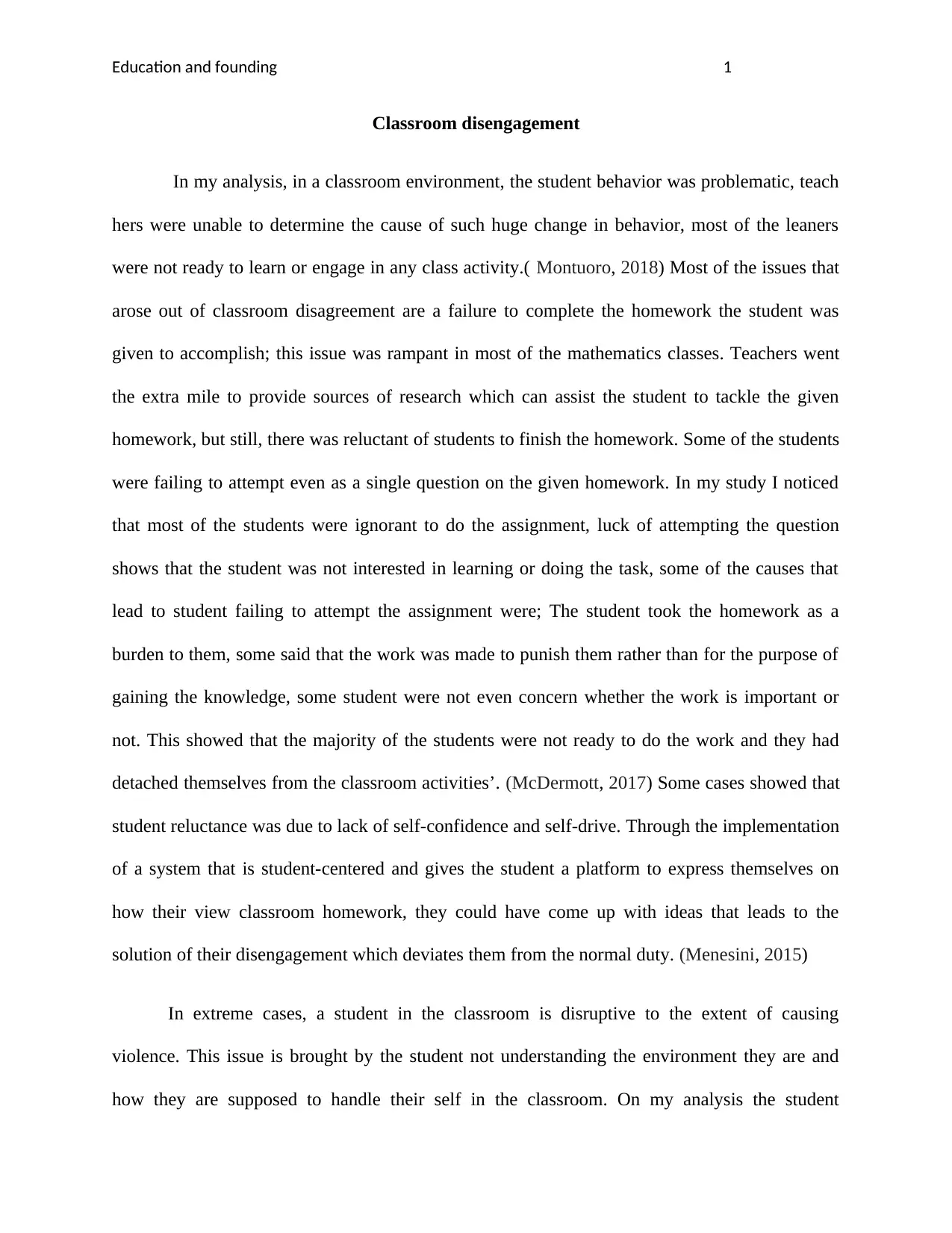
Education and founding 1
Classroom disengagement
In my analysis, in a classroom environment, the student behavior was problematic, teach
hers were unable to determine the cause of such huge change in behavior, most of the leaners
were not ready to learn or engage in any class activity.( Montuoro, 2018) Most of the issues that
arose out of classroom disagreement are a failure to complete the homework the student was
given to accomplish; this issue was rampant in most of the mathematics classes. Teachers went
the extra mile to provide sources of research which can assist the student to tackle the given
homework, but still, there was reluctant of students to finish the homework. Some of the students
were failing to attempt even as a single question on the given homework. In my study I noticed
that most of the students were ignorant to do the assignment, luck of attempting the question
shows that the student was not interested in learning or doing the task, some of the causes that
lead to student failing to attempt the assignment were; The student took the homework as a
burden to them, some said that the work was made to punish them rather than for the purpose of
gaining the knowledge, some student were not even concern whether the work is important or
not. This showed that the majority of the students were not ready to do the work and they had
detached themselves from the classroom activities’. (McDermott, 2017) Some cases showed that
student reluctance was due to lack of self-confidence and self-drive. Through the implementation
of a system that is student-centered and gives the student a platform to express themselves on
how their view classroom homework, they could have come up with ideas that leads to the
solution of their disengagement which deviates them from the normal duty. (Menesini, 2015)
In extreme cases, a student in the classroom is disruptive to the extent of causing
violence. This issue is brought by the student not understanding the environment they are and
how they are supposed to handle their self in the classroom. On my analysis the student
Classroom disengagement
In my analysis, in a classroom environment, the student behavior was problematic, teach
hers were unable to determine the cause of such huge change in behavior, most of the leaners
were not ready to learn or engage in any class activity.( Montuoro, 2018) Most of the issues that
arose out of classroom disagreement are a failure to complete the homework the student was
given to accomplish; this issue was rampant in most of the mathematics classes. Teachers went
the extra mile to provide sources of research which can assist the student to tackle the given
homework, but still, there was reluctant of students to finish the homework. Some of the students
were failing to attempt even as a single question on the given homework. In my study I noticed
that most of the students were ignorant to do the assignment, luck of attempting the question
shows that the student was not interested in learning or doing the task, some of the causes that
lead to student failing to attempt the assignment were; The student took the homework as a
burden to them, some said that the work was made to punish them rather than for the purpose of
gaining the knowledge, some student were not even concern whether the work is important or
not. This showed that the majority of the students were not ready to do the work and they had
detached themselves from the classroom activities’. (McDermott, 2017) Some cases showed that
student reluctance was due to lack of self-confidence and self-drive. Through the implementation
of a system that is student-centered and gives the student a platform to express themselves on
how their view classroom homework, they could have come up with ideas that leads to the
solution of their disengagement which deviates them from the normal duty. (Menesini, 2015)
In extreme cases, a student in the classroom is disruptive to the extent of causing
violence. This issue is brought by the student not understanding the environment they are and
how they are supposed to handle their self in the classroom. On my analysis the student
Secure Best Marks with AI Grader
Need help grading? Try our AI Grader for instant feedback on your assignments.
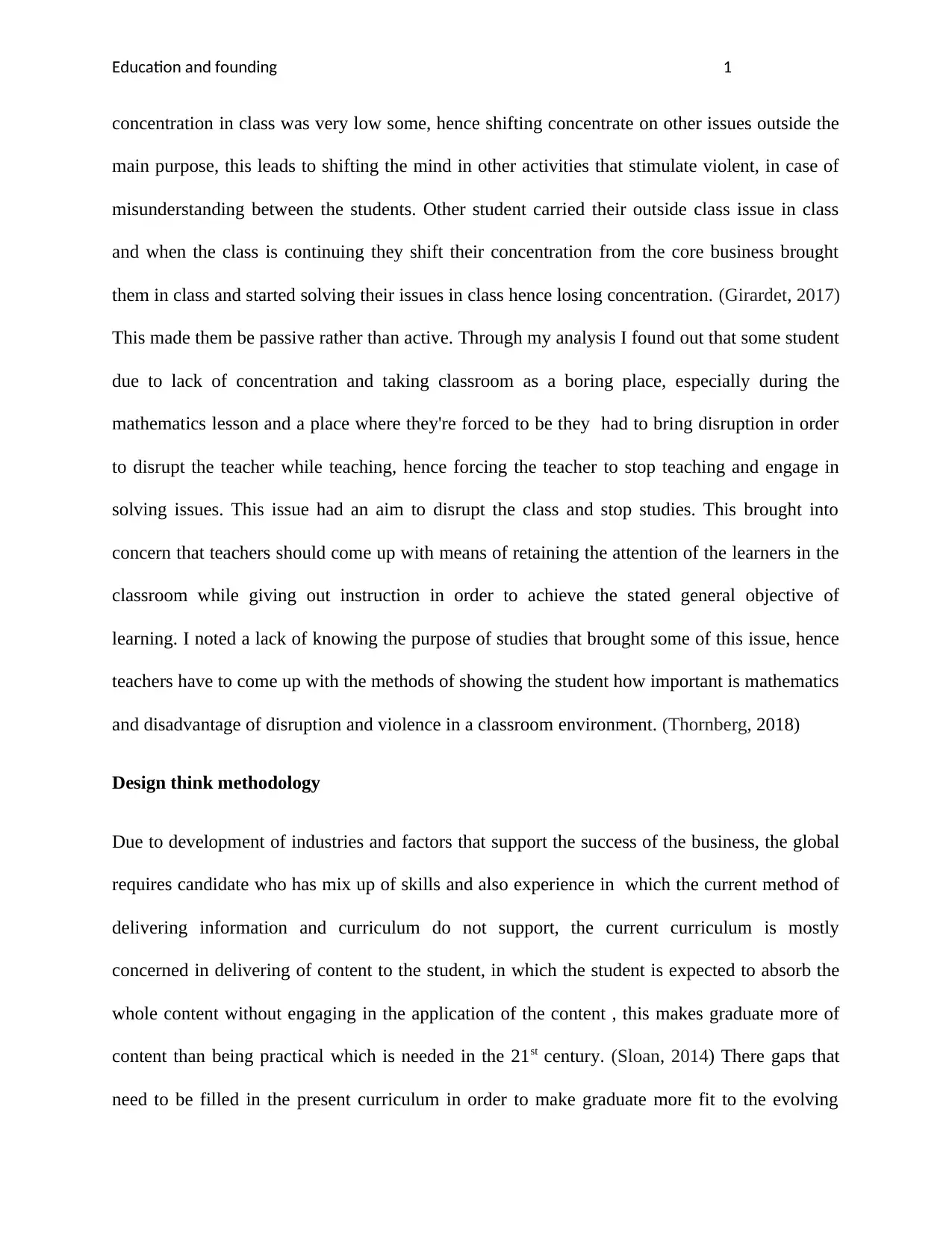
Education and founding 1
concentration in class was very low some, hence shifting concentrate on other issues outside the
main purpose, this leads to shifting the mind in other activities that stimulate violent, in case of
misunderstanding between the students. Other student carried their outside class issue in class
and when the class is continuing they shift their concentration from the core business brought
them in class and started solving their issues in class hence losing concentration. (Girardet, 2017)
This made them be passive rather than active. Through my analysis I found out that some student
due to lack of concentration and taking classroom as a boring place, especially during the
mathematics lesson and a place where they're forced to be they had to bring disruption in order
to disrupt the teacher while teaching, hence forcing the teacher to stop teaching and engage in
solving issues. This issue had an aim to disrupt the class and stop studies. This brought into
concern that teachers should come up with means of retaining the attention of the learners in the
classroom while giving out instruction in order to achieve the stated general objective of
learning. I noted a lack of knowing the purpose of studies that brought some of this issue, hence
teachers have to come up with the methods of showing the student how important is mathematics
and disadvantage of disruption and violence in a classroom environment. (Thornberg, 2018)
Design think methodology
Due to development of industries and factors that support the success of the business, the global
requires candidate who has mix up of skills and also experience in which the current method of
delivering information and curriculum do not support, the current curriculum is mostly
concerned in delivering of content to the student, in which the student is expected to absorb the
whole content without engaging in the application of the content , this makes graduate more of
content than being practical which is needed in the 21st century. (Sloan, 2014) There gaps that
need to be filled in the present curriculum in order to make graduate more fit to the evolving
concentration in class was very low some, hence shifting concentrate on other issues outside the
main purpose, this leads to shifting the mind in other activities that stimulate violent, in case of
misunderstanding between the students. Other student carried their outside class issue in class
and when the class is continuing they shift their concentration from the core business brought
them in class and started solving their issues in class hence losing concentration. (Girardet, 2017)
This made them be passive rather than active. Through my analysis I found out that some student
due to lack of concentration and taking classroom as a boring place, especially during the
mathematics lesson and a place where they're forced to be they had to bring disruption in order
to disrupt the teacher while teaching, hence forcing the teacher to stop teaching and engage in
solving issues. This issue had an aim to disrupt the class and stop studies. This brought into
concern that teachers should come up with means of retaining the attention of the learners in the
classroom while giving out instruction in order to achieve the stated general objective of
learning. I noted a lack of knowing the purpose of studies that brought some of this issue, hence
teachers have to come up with the methods of showing the student how important is mathematics
and disadvantage of disruption and violence in a classroom environment. (Thornberg, 2018)
Design think methodology
Due to development of industries and factors that support the success of the business, the global
requires candidate who has mix up of skills and also experience in which the current method of
delivering information and curriculum do not support, the current curriculum is mostly
concerned in delivering of content to the student, in which the student is expected to absorb the
whole content without engaging in the application of the content , this makes graduate more of
content than being practical which is needed in the 21st century. (Sloan, 2014) There gaps that
need to be filled in the present curriculum in order to make graduate more fit to the evolving
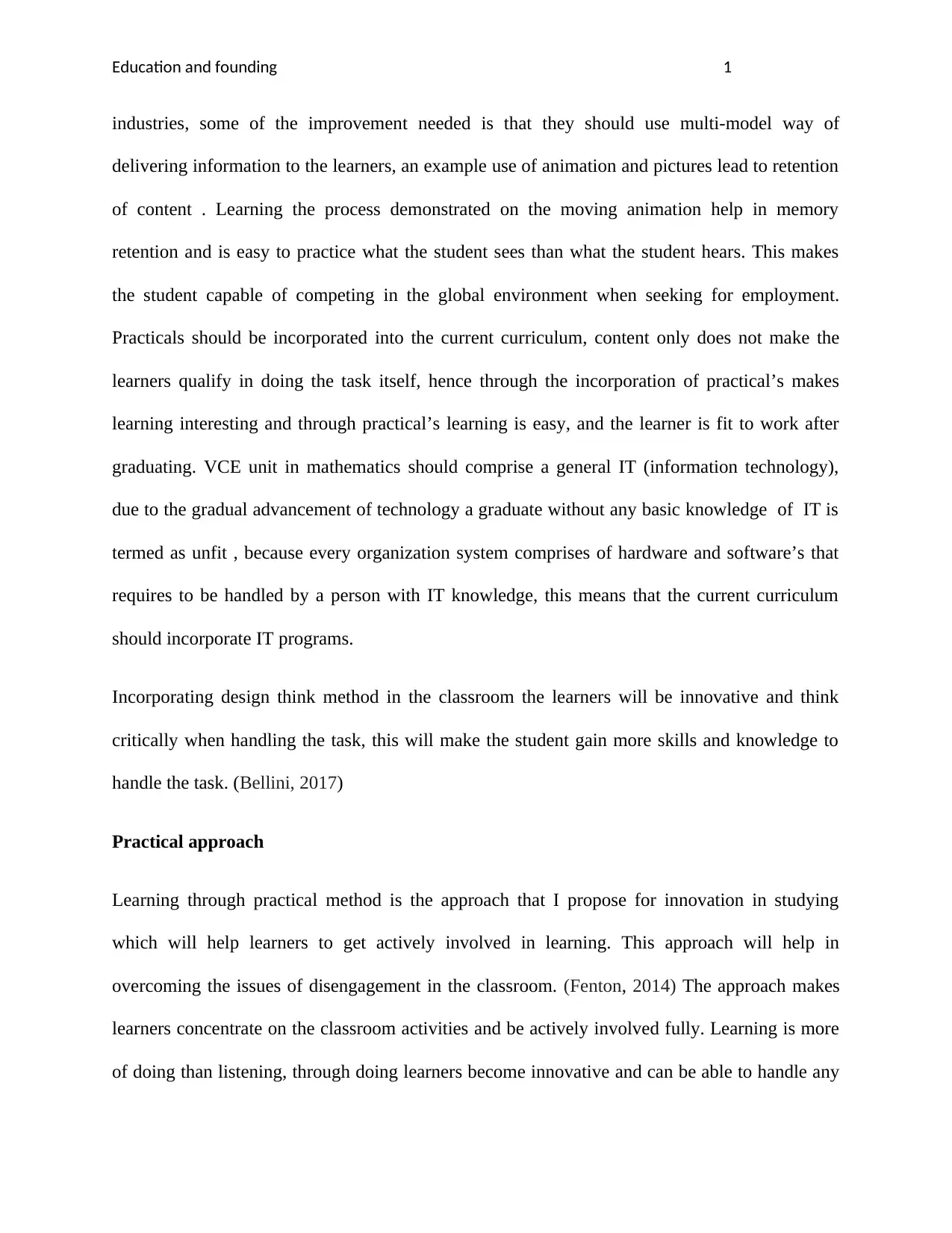
Education and founding 1
industries, some of the improvement needed is that they should use multi-model way of
delivering information to the learners, an example use of animation and pictures lead to retention
of content . Learning the process demonstrated on the moving animation help in memory
retention and is easy to practice what the student sees than what the student hears. This makes
the student capable of competing in the global environment when seeking for employment.
Practicals should be incorporated into the current curriculum, content only does not make the
learners qualify in doing the task itself, hence through the incorporation of practical’s makes
learning interesting and through practical’s learning is easy, and the learner is fit to work after
graduating. VCE unit in mathematics should comprise a general IT (information technology),
due to the gradual advancement of technology a graduate without any basic knowledge of IT is
termed as unfit , because every organization system comprises of hardware and software’s that
requires to be handled by a person with IT knowledge, this means that the current curriculum
should incorporate IT programs.
Incorporating design think method in the classroom the learners will be innovative and think
critically when handling the task, this will make the student gain more skills and knowledge to
handle the task. (Bellini, 2017)
Practical approach
Learning through practical method is the approach that I propose for innovation in studying
which will help learners to get actively involved in learning. This approach will help in
overcoming the issues of disengagement in the classroom. (Fenton, 2014) The approach makes
learners concentrate on the classroom activities and be actively involved fully. Learning is more
of doing than listening, through doing learners become innovative and can be able to handle any
industries, some of the improvement needed is that they should use multi-model way of
delivering information to the learners, an example use of animation and pictures lead to retention
of content . Learning the process demonstrated on the moving animation help in memory
retention and is easy to practice what the student sees than what the student hears. This makes
the student capable of competing in the global environment when seeking for employment.
Practicals should be incorporated into the current curriculum, content only does not make the
learners qualify in doing the task itself, hence through the incorporation of practical’s makes
learning interesting and through practical’s learning is easy, and the learner is fit to work after
graduating. VCE unit in mathematics should comprise a general IT (information technology),
due to the gradual advancement of technology a graduate without any basic knowledge of IT is
termed as unfit , because every organization system comprises of hardware and software’s that
requires to be handled by a person with IT knowledge, this means that the current curriculum
should incorporate IT programs.
Incorporating design think method in the classroom the learners will be innovative and think
critically when handling the task, this will make the student gain more skills and knowledge to
handle the task. (Bellini, 2017)
Practical approach
Learning through practical method is the approach that I propose for innovation in studying
which will help learners to get actively involved in learning. This approach will help in
overcoming the issues of disengagement in the classroom. (Fenton, 2014) The approach makes
learners concentrate on the classroom activities and be actively involved fully. Learning is more
of doing than listening, through doing learners become innovative and can be able to handle any
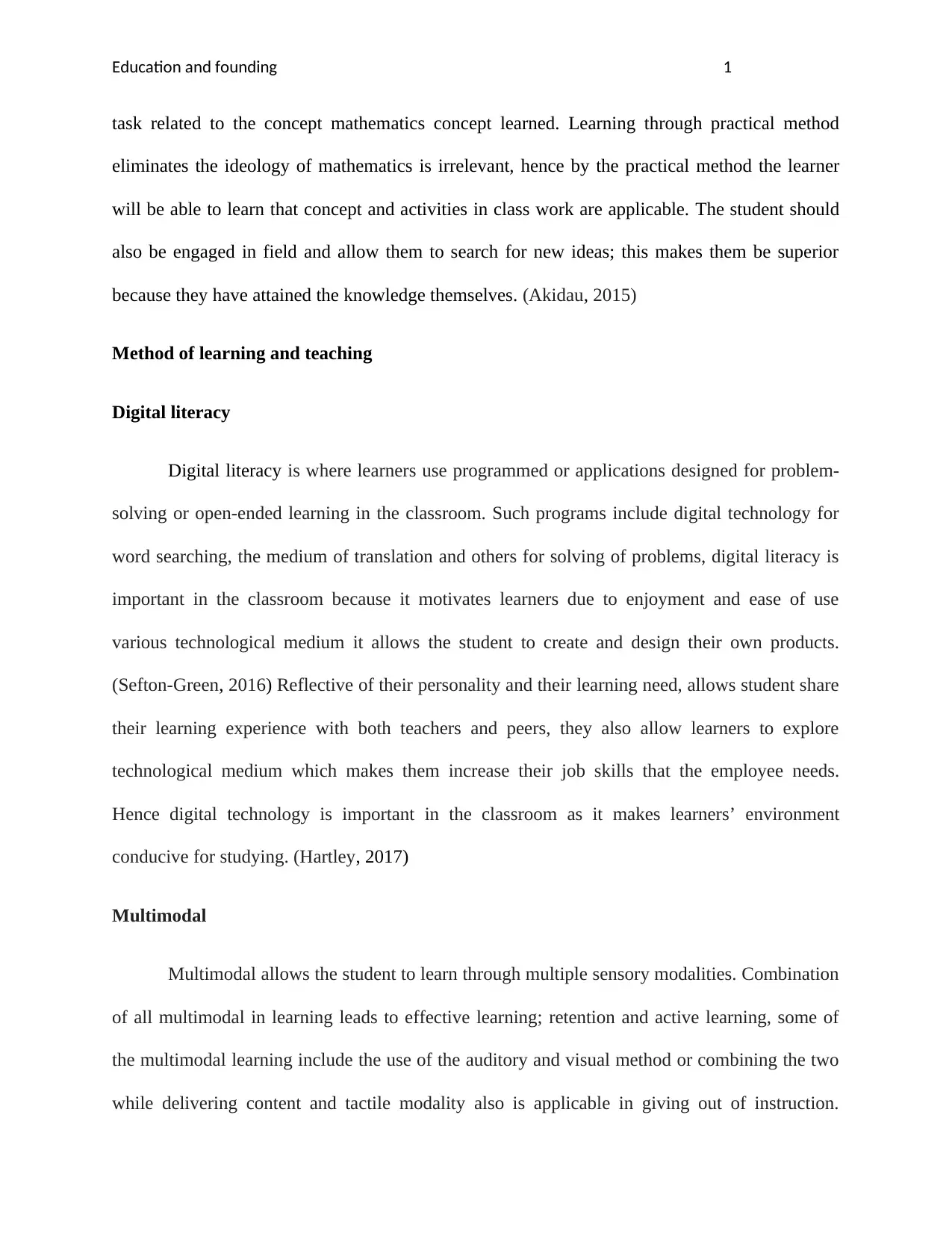
Education and founding 1
task related to the concept mathematics concept learned. Learning through practical method
eliminates the ideology of mathematics is irrelevant, hence by the practical method the learner
will be able to learn that concept and activities in class work are applicable. The student should
also be engaged in field and allow them to search for new ideas; this makes them be superior
because they have attained the knowledge themselves. (Akidau, 2015)
Method of learning and teaching
Digital literacy
Digital literacy is where learners use programmed or applications designed for problem-
solving or open-ended learning in the classroom. Such programs include digital technology for
word searching, the medium of translation and others for solving of problems, digital literacy is
important in the classroom because it motivates learners due to enjoyment and ease of use
various technological medium it allows the student to create and design their own products.
(Sefton-Green, 2016) Reflective of their personality and their learning need, allows student share
their learning experience with both teachers and peers, they also allow learners to explore
technological medium which makes them increase their job skills that the employee needs.
Hence digital technology is important in the classroom as it makes learners’ environment
conducive for studying. (Hartley, 2017)
Multimodal
Multimodal allows the student to learn through multiple sensory modalities. Combination
of all multimodal in learning leads to effective learning; retention and active learning, some of
the multimodal learning include the use of the auditory and visual method or combining the two
while delivering content and tactile modality also is applicable in giving out of instruction.
task related to the concept mathematics concept learned. Learning through practical method
eliminates the ideology of mathematics is irrelevant, hence by the practical method the learner
will be able to learn that concept and activities in class work are applicable. The student should
also be engaged in field and allow them to search for new ideas; this makes them be superior
because they have attained the knowledge themselves. (Akidau, 2015)
Method of learning and teaching
Digital literacy
Digital literacy is where learners use programmed or applications designed for problem-
solving or open-ended learning in the classroom. Such programs include digital technology for
word searching, the medium of translation and others for solving of problems, digital literacy is
important in the classroom because it motivates learners due to enjoyment and ease of use
various technological medium it allows the student to create and design their own products.
(Sefton-Green, 2016) Reflective of their personality and their learning need, allows student share
their learning experience with both teachers and peers, they also allow learners to explore
technological medium which makes them increase their job skills that the employee needs.
Hence digital technology is important in the classroom as it makes learners’ environment
conducive for studying. (Hartley, 2017)
Multimodal
Multimodal allows the student to learn through multiple sensory modalities. Combination
of all multimodal in learning leads to effective learning; retention and active learning, some of
the multimodal learning include the use of the auditory and visual method or combining the two
while delivering content and tactile modality also is applicable in giving out of instruction.
Paraphrase This Document
Need a fresh take? Get an instant paraphrase of this document with our AI Paraphraser
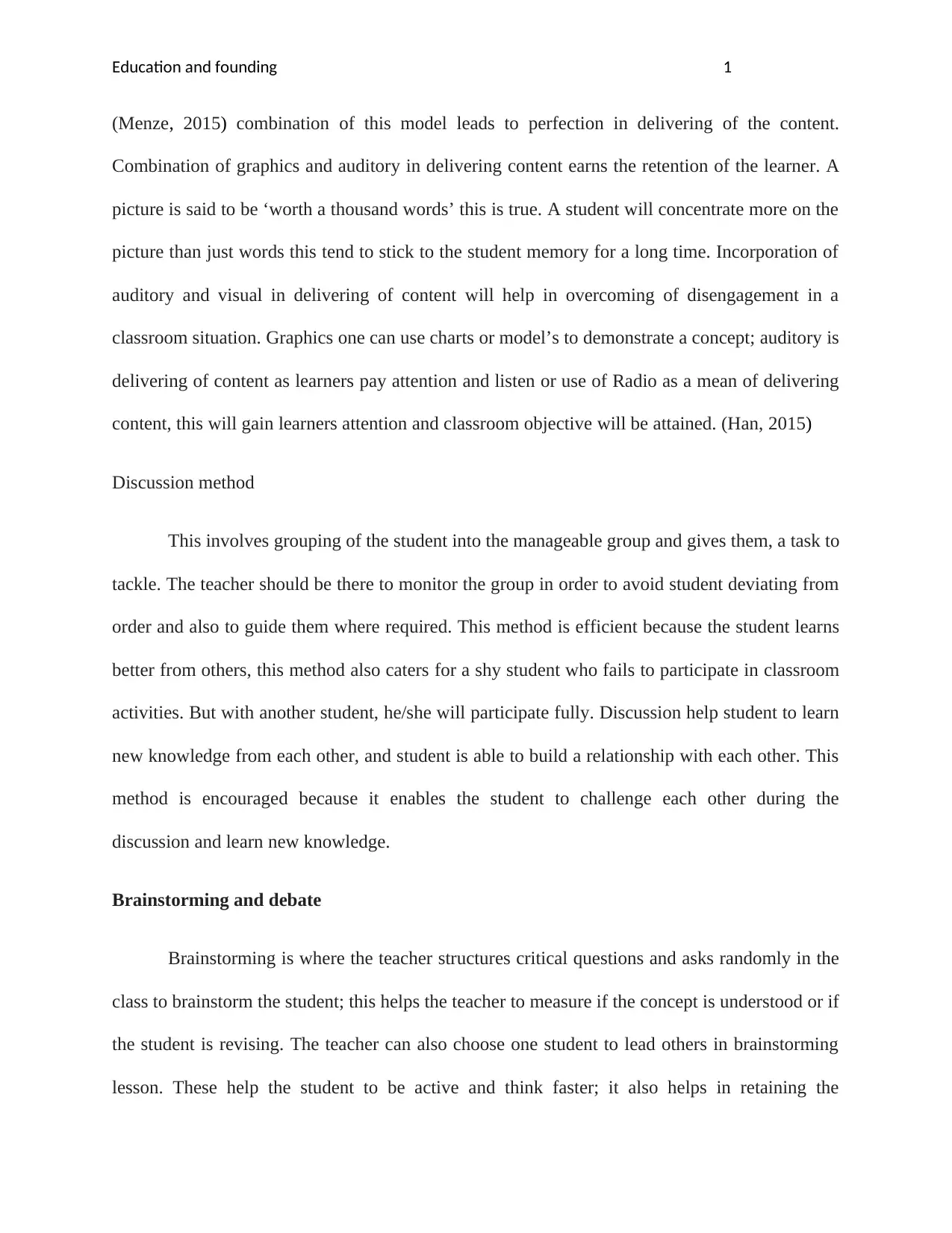
Education and founding 1
(Menze, 2015) combination of this model leads to perfection in delivering of the content.
Combination of graphics and auditory in delivering content earns the retention of the learner. A
picture is said to be ‘worth a thousand words’ this is true. A student will concentrate more on the
picture than just words this tend to stick to the student memory for a long time. Incorporation of
auditory and visual in delivering of content will help in overcoming of disengagement in a
classroom situation. Graphics one can use charts or model’s to demonstrate a concept; auditory is
delivering of content as learners pay attention and listen or use of Radio as a mean of delivering
content, this will gain learners attention and classroom objective will be attained. (Han, 2015)
Discussion method
This involves grouping of the student into the manageable group and gives them, a task to
tackle. The teacher should be there to monitor the group in order to avoid student deviating from
order and also to guide them where required. This method is efficient because the student learns
better from others, this method also caters for a shy student who fails to participate in classroom
activities. But with another student, he/she will participate fully. Discussion help student to learn
new knowledge from each other, and student is able to build a relationship with each other. This
method is encouraged because it enables the student to challenge each other during the
discussion and learn new knowledge.
Brainstorming and debate
Brainstorming is where the teacher structures critical questions and asks randomly in the
class to brainstorm the student; this helps the teacher to measure if the concept is understood or if
the student is revising. The teacher can also choose one student to lead others in brainstorming
lesson. These help the student to be active and think faster; it also helps in retaining the
(Menze, 2015) combination of this model leads to perfection in delivering of the content.
Combination of graphics and auditory in delivering content earns the retention of the learner. A
picture is said to be ‘worth a thousand words’ this is true. A student will concentrate more on the
picture than just words this tend to stick to the student memory for a long time. Incorporation of
auditory and visual in delivering of content will help in overcoming of disengagement in a
classroom situation. Graphics one can use charts or model’s to demonstrate a concept; auditory is
delivering of content as learners pay attention and listen or use of Radio as a mean of delivering
content, this will gain learners attention and classroom objective will be attained. (Han, 2015)
Discussion method
This involves grouping of the student into the manageable group and gives them, a task to
tackle. The teacher should be there to monitor the group in order to avoid student deviating from
order and also to guide them where required. This method is efficient because the student learns
better from others, this method also caters for a shy student who fails to participate in classroom
activities. But with another student, he/she will participate fully. Discussion help student to learn
new knowledge from each other, and student is able to build a relationship with each other. This
method is encouraged because it enables the student to challenge each other during the
discussion and learn new knowledge.
Brainstorming and debate
Brainstorming is where the teacher structures critical questions and asks randomly in the
class to brainstorm the student; this helps the teacher to measure if the concept is understood or if
the student is revising. The teacher can also choose one student to lead others in brainstorming
lesson. These help the student to be active and think faster; it also helps in retaining the
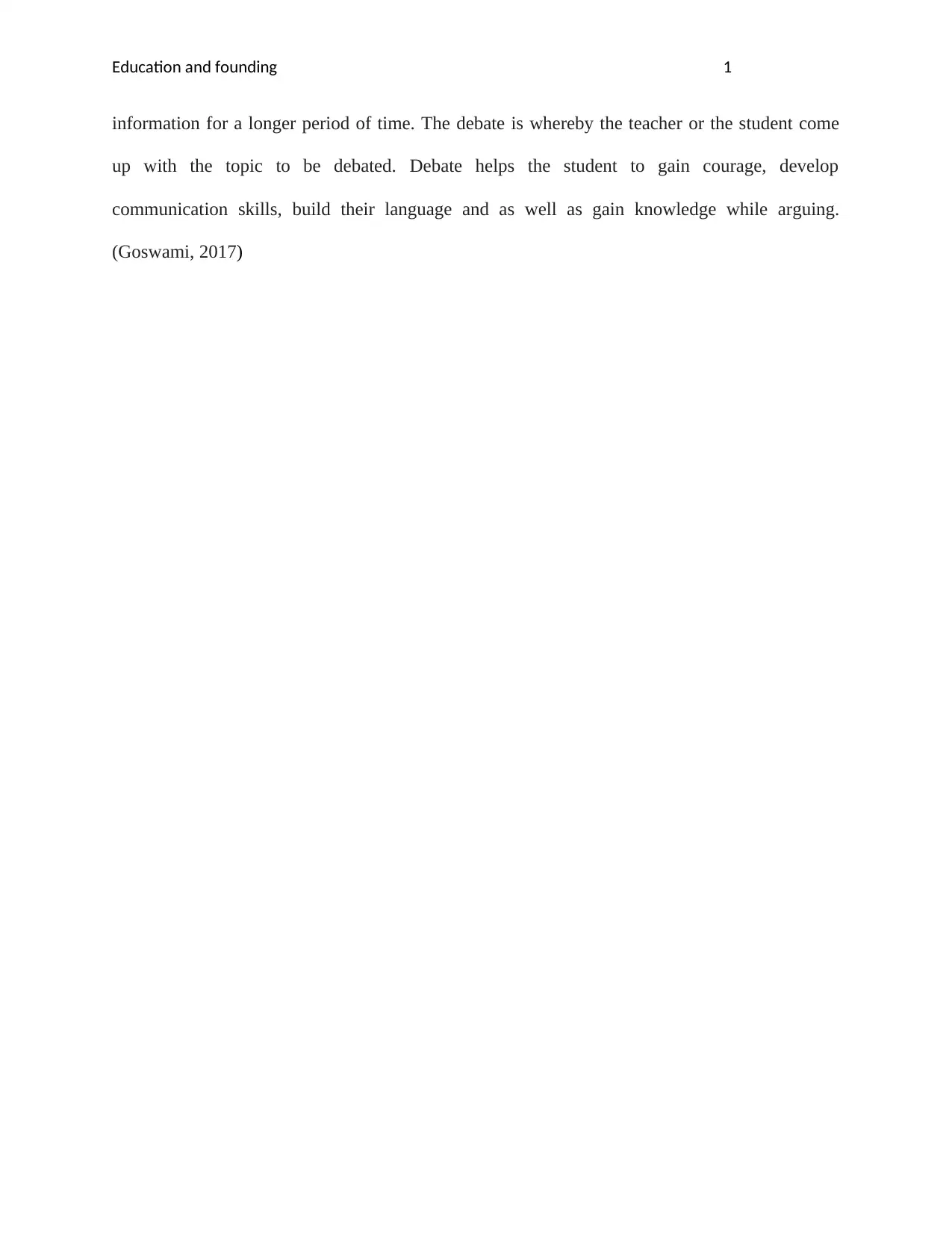
Education and founding 1
information for a longer period of time. The debate is whereby the teacher or the student come
up with the topic to be debated. Debate helps the student to gain courage, develop
communication skills, build their language and as well as gain knowledge while arguing.
(Goswami, 2017)
information for a longer period of time. The debate is whereby the teacher or the student come
up with the topic to be debated. Debate helps the student to gain courage, develop
communication skills, build their language and as well as gain knowledge while arguing.
(Goswami, 2017)
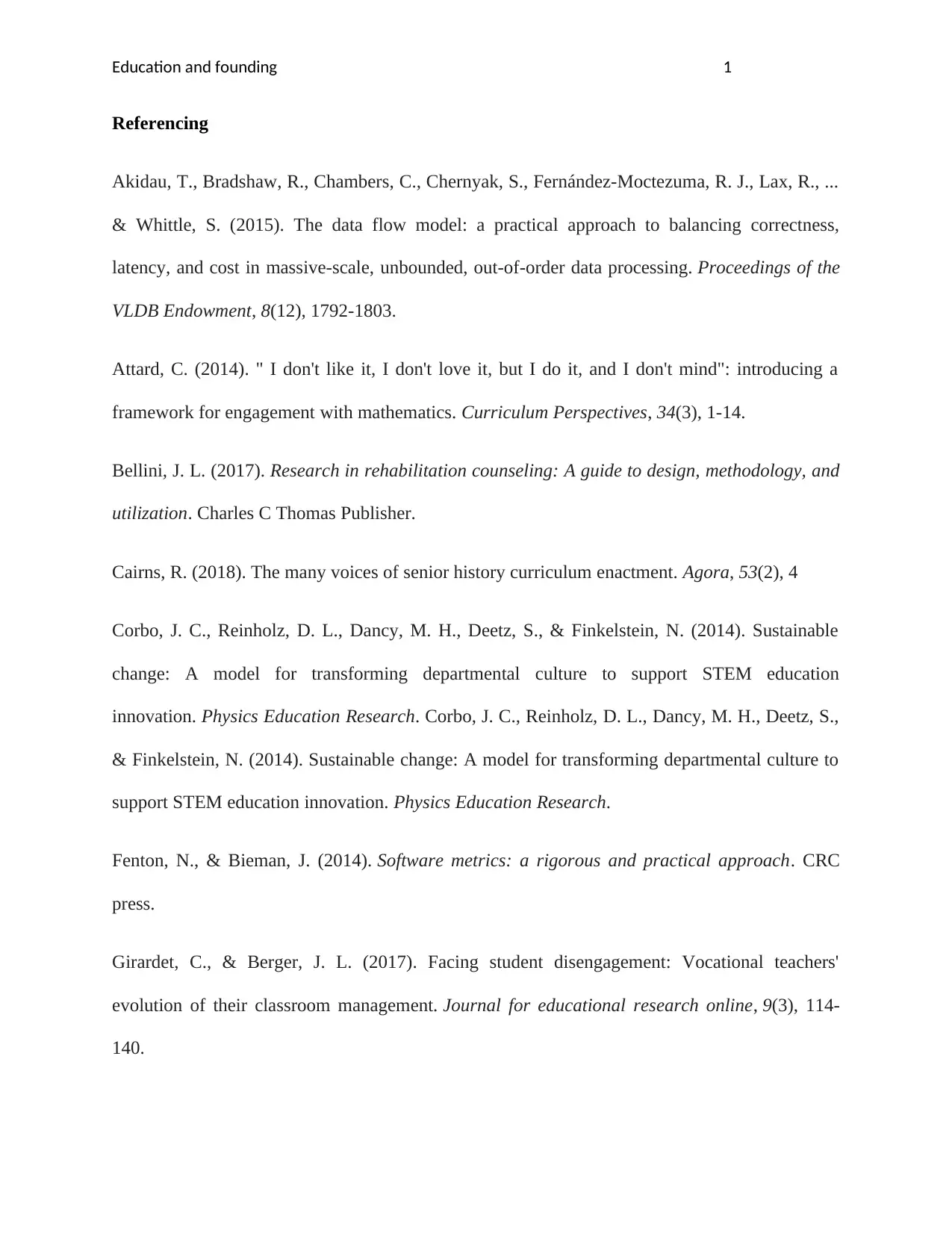
Education and founding 1
Referencing
Akidau, T., Bradshaw, R., Chambers, C., Chernyak, S., Fernández-Moctezuma, R. J., Lax, R., ...
& Whittle, S. (2015). The data flow model: a practical approach to balancing correctness,
latency, and cost in massive-scale, unbounded, out-of-order data processing. Proceedings of the
VLDB Endowment, 8(12), 1792-1803.
Attard, C. (2014). " I don't like it, I don't love it, but I do it, and I don't mind": introducing a
framework for engagement with mathematics. Curriculum Perspectives, 34(3), 1-14.
Bellini, J. L. (2017). Research in rehabilitation counseling: A guide to design, methodology, and
utilization. Charles C Thomas Publisher.
Cairns, R. (2018). The many voices of senior history curriculum enactment. Agora, 53(2), 4
Corbo, J. C., Reinholz, D. L., Dancy, M. H., Deetz, S., & Finkelstein, N. (2014). Sustainable
change: A model for transforming departmental culture to support STEM education
innovation. Physics Education Research. Corbo, J. C., Reinholz, D. L., Dancy, M. H., Deetz, S.,
& Finkelstein, N. (2014). Sustainable change: A model for transforming departmental culture to
support STEM education innovation. Physics Education Research.
Fenton, N., & Bieman, J. (2014). Software metrics: a rigorous and practical approach. CRC
press.
Girardet, C., & Berger, J. L. (2017). Facing student disengagement: Vocational teachers'
evolution of their classroom management. Journal for educational research online, 9(3), 114-
140.
Referencing
Akidau, T., Bradshaw, R., Chambers, C., Chernyak, S., Fernández-Moctezuma, R. J., Lax, R., ...
& Whittle, S. (2015). The data flow model: a practical approach to balancing correctness,
latency, and cost in massive-scale, unbounded, out-of-order data processing. Proceedings of the
VLDB Endowment, 8(12), 1792-1803.
Attard, C. (2014). " I don't like it, I don't love it, but I do it, and I don't mind": introducing a
framework for engagement with mathematics. Curriculum Perspectives, 34(3), 1-14.
Bellini, J. L. (2017). Research in rehabilitation counseling: A guide to design, methodology, and
utilization. Charles C Thomas Publisher.
Cairns, R. (2018). The many voices of senior history curriculum enactment. Agora, 53(2), 4
Corbo, J. C., Reinholz, D. L., Dancy, M. H., Deetz, S., & Finkelstein, N. (2014). Sustainable
change: A model for transforming departmental culture to support STEM education
innovation. Physics Education Research. Corbo, J. C., Reinholz, D. L., Dancy, M. H., Deetz, S.,
& Finkelstein, N. (2014). Sustainable change: A model for transforming departmental culture to
support STEM education innovation. Physics Education Research.
Fenton, N., & Bieman, J. (2014). Software metrics: a rigorous and practical approach. CRC
press.
Girardet, C., & Berger, J. L. (2017). Facing student disengagement: Vocational teachers'
evolution of their classroom management. Journal for educational research online, 9(3), 114-
140.
Secure Best Marks with AI Grader
Need help grading? Try our AI Grader for instant feedback on your assignments.
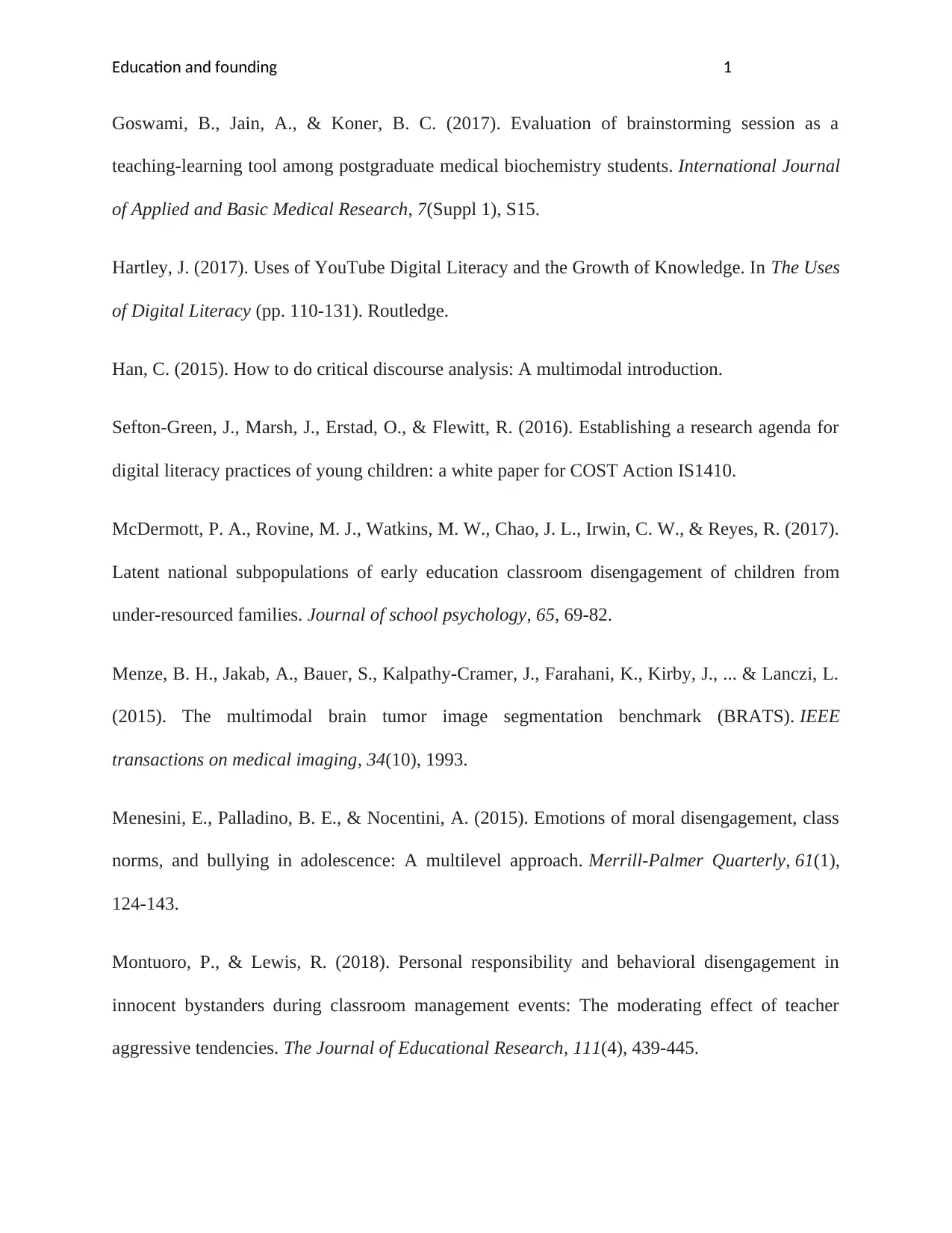
Education and founding 1
Goswami, B., Jain, A., & Koner, B. C. (2017). Evaluation of brainstorming session as a
teaching-learning tool among postgraduate medical biochemistry students. International Journal
of Applied and Basic Medical Research, 7(Suppl 1), S15.
Hartley, J. (2017). Uses of YouTube Digital Literacy and the Growth of Knowledge. In The Uses
of Digital Literacy (pp. 110-131). Routledge.
Han, C. (2015). How to do critical discourse analysis: A multimodal introduction.
Sefton-Green, J., Marsh, J., Erstad, O., & Flewitt, R. (2016). Establishing a research agenda for
digital literacy practices of young children: a white paper for COST Action IS1410.
McDermott, P. A., Rovine, M. J., Watkins, M. W., Chao, J. L., Irwin, C. W., & Reyes, R. (2017).
Latent national subpopulations of early education classroom disengagement of children from
under-resourced families. Journal of school psychology, 65, 69-82.
Menze, B. H., Jakab, A., Bauer, S., Kalpathy-Cramer, J., Farahani, K., Kirby, J., ... & Lanczi, L.
(2015). The multimodal brain tumor image segmentation benchmark (BRATS). IEEE
transactions on medical imaging, 34(10), 1993.
Menesini, E., Palladino, B. E., & Nocentini, A. (2015). Emotions of moral disengagement, class
norms, and bullying in adolescence: A multilevel approach. Merrill-Palmer Quarterly, 61(1),
124-143.
Montuoro, P., & Lewis, R. (2018). Personal responsibility and behavioral disengagement in
innocent bystanders during classroom management events: The moderating effect of teacher
aggressive tendencies. The Journal of Educational Research, 111(4), 439-445.
Goswami, B., Jain, A., & Koner, B. C. (2017). Evaluation of brainstorming session as a
teaching-learning tool among postgraduate medical biochemistry students. International Journal
of Applied and Basic Medical Research, 7(Suppl 1), S15.
Hartley, J. (2017). Uses of YouTube Digital Literacy and the Growth of Knowledge. In The Uses
of Digital Literacy (pp. 110-131). Routledge.
Han, C. (2015). How to do critical discourse analysis: A multimodal introduction.
Sefton-Green, J., Marsh, J., Erstad, O., & Flewitt, R. (2016). Establishing a research agenda for
digital literacy practices of young children: a white paper for COST Action IS1410.
McDermott, P. A., Rovine, M. J., Watkins, M. W., Chao, J. L., Irwin, C. W., & Reyes, R. (2017).
Latent national subpopulations of early education classroom disengagement of children from
under-resourced families. Journal of school psychology, 65, 69-82.
Menze, B. H., Jakab, A., Bauer, S., Kalpathy-Cramer, J., Farahani, K., Kirby, J., ... & Lanczi, L.
(2015). The multimodal brain tumor image segmentation benchmark (BRATS). IEEE
transactions on medical imaging, 34(10), 1993.
Menesini, E., Palladino, B. E., & Nocentini, A. (2015). Emotions of moral disengagement, class
norms, and bullying in adolescence: A multilevel approach. Merrill-Palmer Quarterly, 61(1),
124-143.
Montuoro, P., & Lewis, R. (2018). Personal responsibility and behavioral disengagement in
innocent bystanders during classroom management events: The moderating effect of teacher
aggressive tendencies. The Journal of Educational Research, 111(4), 439-445.
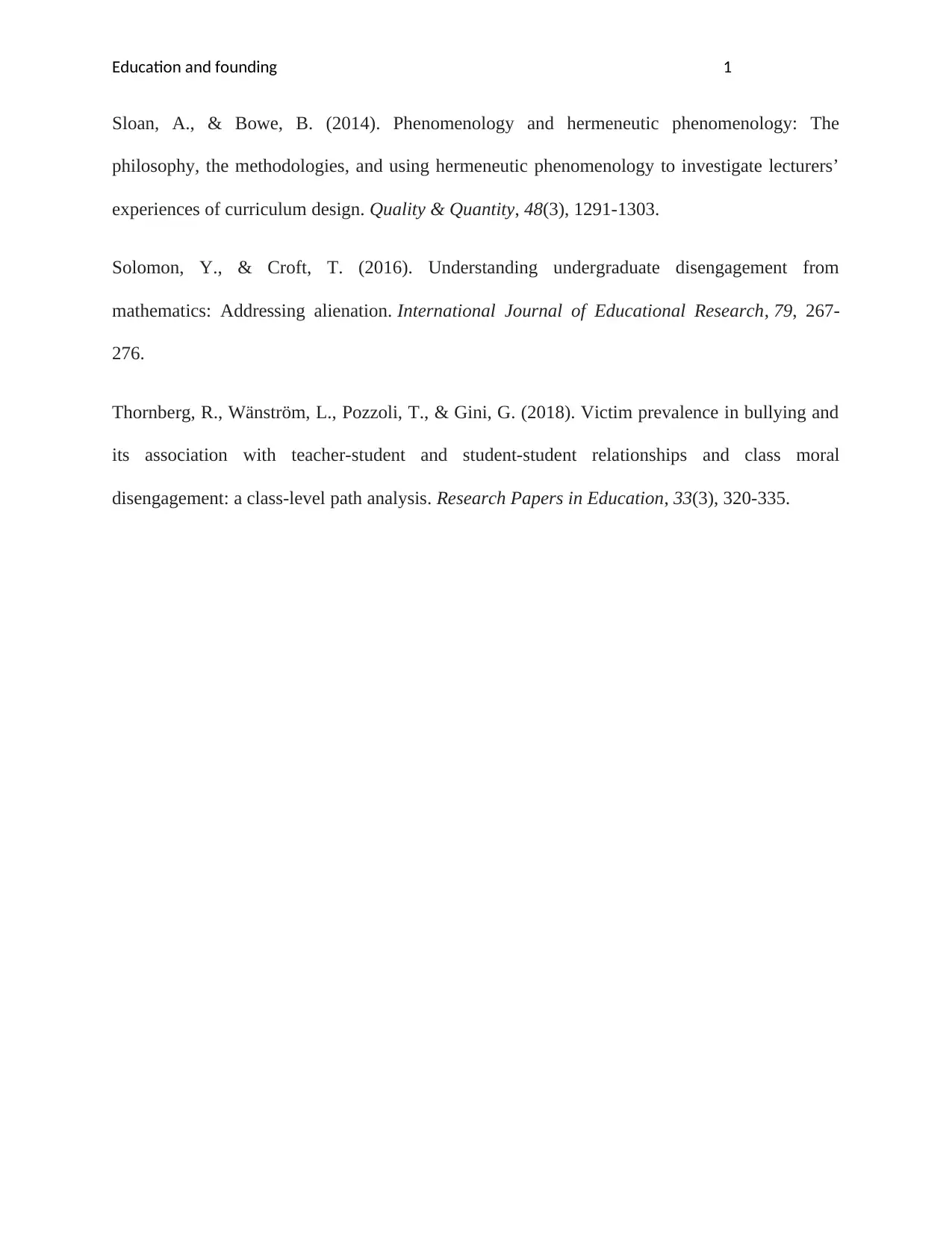
Education and founding 1
Sloan, A., & Bowe, B. (2014). Phenomenology and hermeneutic phenomenology: The
philosophy, the methodologies, and using hermeneutic phenomenology to investigate lecturers’
experiences of curriculum design. Quality & Quantity, 48(3), 1291-1303.
Solomon, Y., & Croft, T. (2016). Understanding undergraduate disengagement from
mathematics: Addressing alienation. International Journal of Educational Research, 79, 267-
276.
Thornberg, R., Wänström, L., Pozzoli, T., & Gini, G. (2018). Victim prevalence in bullying and
its association with teacher-student and student-student relationships and class moral
disengagement: a class-level path analysis. Research Papers in Education, 33(3), 320-335.
Sloan, A., & Bowe, B. (2014). Phenomenology and hermeneutic phenomenology: The
philosophy, the methodologies, and using hermeneutic phenomenology to investigate lecturers’
experiences of curriculum design. Quality & Quantity, 48(3), 1291-1303.
Solomon, Y., & Croft, T. (2016). Understanding undergraduate disengagement from
mathematics: Addressing alienation. International Journal of Educational Research, 79, 267-
276.
Thornberg, R., Wänström, L., Pozzoli, T., & Gini, G. (2018). Victim prevalence in bullying and
its association with teacher-student and student-student relationships and class moral
disengagement: a class-level path analysis. Research Papers in Education, 33(3), 320-335.
1 out of 12
Related Documents
Your All-in-One AI-Powered Toolkit for Academic Success.
+13062052269
info@desklib.com
Available 24*7 on WhatsApp / Email
![[object Object]](/_next/static/media/star-bottom.7253800d.svg)
Unlock your academic potential
© 2024 | Zucol Services PVT LTD | All rights reserved.





